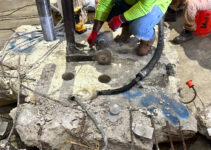
A team member takes core samples from part of the pool deck as part of the investigation into the collapse of Champlain Towers South.
Photo courtesy of NIST
Newly analyzed evidence in the investigation into the June 2021 partial collapse of Champlain Towers South that killed 98 people in Surfside, Fla., shows that the pool deck collapsed more than four minutes before the tower itself. But investigators are still working to determine the initiating event, and aim to finish their technical work this summer.
The team from the U.S. Dept. of Commerce’s National Institute of Standards and Technology (NIST) investigating the collapse shared an update on their progress during a National Construction Safety Team Advisory Committee meeting March 7.
Investigators’ analysis of videos shot in and around the building—including two new videos they obtained in December, as well as interviews with witnesses—helped clarify the timeline of the collapse, according to Judith Mitrani-Reiser, the NIST investigation team lead. David Goodwin, a project leader on the investigation, said a video with a view into the Champlain Towers South parking garage under the pool deck, when enhanced with help from the FBI, showed fallen debris before the tower’s collapse. Though still a preliminary analysis, the enhanced video appears to show parts of planter boxes and patio furniture, which had been on the pool deck, in the garage below. One column is not visible where investigators believe it should be, but Goodwin said that could be due to obstructions or poor lighting.
Emel Ganapati, a project leader on the team, said some residents in a particular apartment stack of the building described hearing noises on the night of the collapse. They compared the noises to knocking, hammering or furniture being moved above them.
“The noises reportedly became louder and louder and more intense prior to … the pool deck collapse,” Ganapati said.
Other videos revealed distinct signs of movement and damage in the tower, including a hallway floor that was sagging before part of the tower dropped. And video from a nearby building shows the tower’s drop initiated on a portion of the tower’s south face—the side by the pool—below the third floor level and spread northward from there, according to Jack Moehle, an investigation project leader.
“The first two of the videos, along with the eyewitness accounts, provide compelling evidence that the first major collapse was in the pool deck,” Moehle said.
Investigators had previously highlighted design deficiencies and construction deviations they found in the pool deck, as well as photos that showed signs of distress in part of the pool deck where planters had been added. Georgette Hlepas, an investigation project leader, described how water was seen ponding around some of the pool deck drains and damage from seepage was discovered in the ceiling of the garage below.
Tower Deficiencies
However, the pool deck is not the team’s only failure hypothesis. Further structural analysis also revealed deficiencies in the tower’s design that did not meet building code or common standards at the time it was built, according to James Harris, an investigation project leader. There were also construction deviations in the tower, such as in columns where reinforcing bars were installed with less overlap between upper and lower sets than the minimum allowed by the building code, which is what had been specified on the drawings.
Investigators are still working through various hypotheses about what factors may have played roles in the collapse, said Glenn Bell, NIST team associate lead.
“While there is strong evidence that the collapse initiated in the pool deck, we have not yet ruled out a failure initiation in some part of the tower that precipitated the collapse in the pool deck,” Bell said.
The team has also been testing materials and simulating material degradation to better understand key points in the structure. Investigators have extracted 497 concrete cores and completed hundreds of mechanical tests for compressive strength, modulus of elasticity and splitting tensile strength. They have also extracted 369 reinforcing bars and completed 40 tests for tensile properties.
Investigators are projecting substantial completion of technical work by the end of July, Bell said. They will then prepare their report and recommendations, and expect to release a draft report in May 2025, followed by the final report in the fall of 2025 after a public comment period.
“For the next six months, the major driver of our investigative activities will be substantial completion of our technical work through the analysis of failure hypotheses,” Bell said. “As we’re zeroing in on the most likely hypotheses, thoroughness and rigor demand that we sufficiently analyze all reasonable possible scenarios.”
James Leggate is an online news editor at ENR. He has reported on a variety of issues for more than 10 years and his work has contributed to several regional Associated Press Media Editors and Murrow award wins.

